Annual Leave Policy Format Template
1. PURPOSE
1.1. To notify employees about the policy and procedure for Annual Leave.
1.2. To standardize the processing of Annual Leave and Compensatory off for Public Holidays and Excess hours.
2. POLICY
2.1. The Head of each Department is responsible for scheduling Annual Leave for all Employees throughout the year to make sure there is no hindrance to operations.
2.2. All departments will carry an Annual Leave plan with instructions as to how many staff may be on annual leave at any one time for the Calendar/Financial year; the numbers include those staff on scheduled maternity leave. (Maternity leave must be booked on the relevant department planners immediately a confirmation of pregnancy is received).
2.3. The organization prefers that the option for annual leave is taken by employees (if the employees are able to do so) and this should be treated as a right but with proper planning undertaken.
2.4. Any Annual Leave to be taken must be applied for one month in advance using the individual login access in the Oracle HR Fusion system and has to be approved by the direct manager followed by the head of department.
2.5. After one year of service, the employee is entitled to 30 consecutive days of annual leave. (Annual leave is paid in calendar days NOT working days).
2.6. For service less than one year, leave is accrued at 2 days per month, i.e., 24 consecutive days per year. Annual leave will be paid only after probation period (3 to 6 months) has been successfully completed. Unpaid leave may be taken before this time if service provision permits.
2.7. Annual Leave cannot be accumulated at the rate of more than 15 days per year for more than 3 years (45 days). The employee will be notified as soon as the employee accumulates 45 days of annual leave as to the options: to take leave or be paid out.
2.8. The employee may be paid his salary in advance for his annual leave [basic salary plus accommodation allowance (on request)]. Annual leave pay is based on basic salary plus accommodation allowance; it does not include travel allowance.
2.9. An employee is entitled to the following public holidays as decreed from time to time:
- 2.9.1. Gregorian New Year Day (One Day)
- 2.9.2. National Day (One Day)
2.10. Public Holidays falling within Annual Leave are counted as part of the annual leave quota.
2.11. Excess Hours worked can be accumulated to the amount of 96 hours and taken as compensatory off, with the same rules applied as those pertaining to Annual Leave. Hours over and above 96 are paid as overtime in the next payroll run as applicable. Please see OT and compensatory off policy.
2.12. Compensatory off for Public Holidays can be added to the annual leave, if pre-approved.
2.13. If Leave is cancelled or needs to be postponed then the “Leave withdrawal” online application is required to be sent by the employees before the leave starts.
2.14. Annual Leave allowances will be available 3 days prior to travel.
2.15. A Fixed travel allowance will be given for the ticket to home country, as per the contract of employment. This allowance is automatically added to the employee’s salary every year / two years as per contract on the contract renewal date.
2.16. Annual or compensatory leave greater than 30 days (in total) in the clinical area must be pre-approved by the Hospital Administrator / COO / CEO. Staff who only receive a return ticket every two years are allowed to avail the full 60 days owed to them.
2.17. All Heads of Department must allocate and get the sign off from the person who is responsible for taking care of patient care issues, in their absence. This includes but is not limited to: urgent follow-ups, results, and reports. The signed form needs to be uploaded into the Oracle HR Fusion system together with the application through the ‘Upload document function’ so that there is an audit trail of service cover. The Line manager/ HOD responsible for approving the leave in the first instance MUST attach the service schedule before the leave goes for approval to the next in line (COO/CEO).
2.18. If a service is to be left without cover, the COO / CEO must approve the leave BEFORE a physician can assume it has been granted.
3. PROCEDURE
3.1. The Employee will complete an online leave Application through the Oracle Fusion HR system at least one month in advance and send it to the direct manager/supervisor.
3.2. The Direct manager/supervisor will review the application and approve or disapprove within a turnaround time of 2 working days.
3.3. If the application is approved by the department manager it will be forwarded to the department manager’s line manager for his/her review and approval. The turnaround time for this approval will be 2 working days.
3.4. Once the application has been approved, the Employee gets the system notification confirming the leave has been approved.
3.5. If the leave is not approved by the department manager, employee gets a system notification of leave disapproval.
3.6. The department manager and the line manager of the department manager can request for additional information through the system/verbally, if deemed required. If any changes need to be made to the Leave, the Employee should withdraw the existing application and resubmit an amended online leave request.
3.7. If an Employee is not satisfied with the disapproval reasons on his/her leave request then his/her concerns can be raised by approaching the manager and discussing the best way forward. Escalation may occur to higher management.
3.8. The Employee can also put forward his/her concerns through the Grievance handling mechanism if the concerns are not resolved by discussion.
4. REFERENCES
- 4.1. Labor Law
- 4.2. Policy & Procedure on Grievances
- 4.3. Leave, maternity
- 4.4. Overtime and Compensatory off
Annual Leave Policy Format Template
# Annual Leave Policy
## 1. Purpose and Scope
This Annual Leave Policy outlines the entitlements, procedures, and guidelines for employees taking paid time off from work. This policy applies to all full-time and part-time employees of the organization.
## 2. Leave Entitlement
### 2.1 Full-Time Employees
Full-time employees are entitled to a minimum of 20 working days of paid annual leave per calendar year. This entitlement increases based on length of service as follows:
- 0-2 years of service: 20 days
- 3-5 years of service: 22 days
- 6-10 years of service: 25 days
- 10+ years of service: 28 days
### 2.2 Part-Time Employees
Part-time employees receive annual leave on a pro-rata basis, calculated according to their contracted working hours.
### 2.3 New Employees
New employees will accrue annual leave from their first day of employment. During the first year, leave entitlement is calculated on a pro-rata basis from the start date to the end of the calendar year.
## 3. Leave Year
The annual leave year runs from January 1st to December 31st.
## 4. Accrual of Leave
Annual leave accrues on a monthly basis throughout the year. Employees accrue 1/12th of their annual entitlement each month.
## 5. Requesting Annual Leave
### 5.1 Advance Notice
Employees must submit leave requests in advance using the designated leave management system or request form:
- 1-3 days leave: minimum 1 week notice
- 4-10 days leave: minimum 2 weeks notice
- 10+ days leave: minimum 4 weeks notice
### 5.2 Approval Process
All leave requests must be approved by the employee's direct supervisor or line manager. Approval is subject to business needs and adequate departmental coverage.
### 5.3 Peak Periods
During busy periods or peak business times, leave may be restricted. Employees will be notified in advance of any blackout periods where leave cannot be taken.
## 6. Carry Over and Expiry
### 6.1 Standard Carry Over
Employees may carry over up to 5 days of unused annual leave to the following year. These days must be used within the first quarter (by March 31st) or they will be forfeited.
### 6.2 Exceptions
In exceptional circumstances, such as operational requirements preventing leave being taken, managers may authorize additional carry over with written approval from Human Resources.
## 7. Public Holidays
Public holidays are separate from annual leave entitlement and do not count as annual leave days. The organization observes all statutory public holidays as per local regulations.
## 8. Payment in Lieu
Annual leave should normally be taken during the employment period. Payment in lieu of unused leave will only be made upon termination of employment, subject to local labor laws.
## 9. Leave During Notice Period
Employees serving notice may be required to take any outstanding annual leave during their notice period. Alternatively, management may request employees to work through their notice period with payment made for unused leave upon departure.
## 10. Extended Leave
Employees wishing to take more than 10 consecutive days of leave must discuss this with their manager at least 8 weeks in advance to ensure appropriate coverage arrangements.
## 11. Emergency Leave
In cases of genuine emergency, employees should contact their manager as soon as possible. Retrospective leave requests will be considered on a case-by-case basis.
## 12. Leave Records
### 12.1 Employee Responsibility
Employees are responsible for monitoring their own leave balance and ensuring they take their entitled leave throughout the year.
### 12.2 Manager Responsibility
Managers should actively encourage employees to take their annual leave and ensure leave is distributed throughout the year.
### 12.3 HR Records
Human Resources maintains official records of all leave taken and leave balances for all employees.
## 13. Cancellation of Approved Leave
The organization reserves the right to cancel approved leave in exceptional circumstances, such as emergencies or critical business needs. Reasonable notice will be provided, and any costs incurred by the employee will be reimbursed.
## 14. Sickness During Annual Leave
If an employee falls ill during approved annual leave and provides appropriate medical certification, the sick days may be recorded as sick leave rather than annual leave, subject to the organization's sick leave policy.
## 15. Unauthorized Absence
Taking leave without prior approval or exceeding approved leave dates will be treated as unauthorized absence and may result in disciplinary action, including potential dismissal.
## 16. Returning from Leave
Employees must return to work on the first scheduled working day following their leave period. Failure to return without valid reason may be treated as unauthorized absence.
## 17. Policy Compliance
All employees and managers are expected to comply with this policy. Questions regarding this policy should be directed to Human Resources.
## 18. Policy Review
This policy will be reviewed annually and may be amended as necessary to reflect changes in employment law or organizational requirements. Employees will be notified of any changes.
---
**Document Version:** 1.0
**Effective Date:** [Insert Date]
**Last Reviewed:** [Insert Date]
**Next Review Date:** [Insert Date]
**Policy Owner:** Human Resources Department
What is an Annual Leave Policy and Why is it Important?
An Annual Leave Policy is a formal document that outlines the rules, procedures, and entitlements regarding paid time off for employees within an organization. It serves multiple critical purposes:
- Establishes clear expectations for both employees and management regarding vacation time
- Ensures legal compliance with labor laws and employment standards
- Promotes work-life balance and employee wellbeing
- Prevents misunderstandings and disputes about leave entitlements
- Provides a framework for fair and consistent leave management across the organization
- Helps with workforce planning and operational continuity
- Protects both employer and employee rights
A well-crafted policy reduces ambiguity, supports transparency, and contributes to a positive workplace culture where employees feel valued and respected.
Who Should Issue Annual Leave Policy Communications?
The authority to issue annual leave policy communications typically rests with:
- Human Resources Department: Primary issuer of policy documents, updates, and official communications
- Department Managers/Supervisors: Approve or deny specific leave requests and communicate decisions
- Senior Management/Executive Team: Announce major policy changes or company-wide leave initiatives
- Payroll Department: Provide leave balance statements and accrual information
- Legal/Compliance Officers: Issue policy updates related to regulatory changes
The sender should have the appropriate authority level for the specific communication type. Routine approvals come from direct supervisors, while policy changes require HR or executive authorization.
Elements and Structure of Annual Leave Communications
Effective annual leave communications should include:
- Clear subject line: Immediately identifies the purpose (e.g., "Annual Leave Request," "Leave Policy Update")
- Recipient information: Employee name, department, employee ID when relevant
- Specific dates: Exact leave period with start and end dates
- Leave type: Specify whether it's annual leave, sick leave, unpaid leave, etc.
- Leave balance information: Current balance, days requested, remaining balance
- Approval status: Clear indication of approved, pending, or denied status
- Reasoning: Explanation for denials or special conditions
- Action required: Any steps the employee must take (submit forms, arrange coverage)
- Contact information: Who to reach for questions or concerns
- Acknowledgment request: When confirmation of receipt is needed
- Attachments: Leave request forms, policy documents, or supporting documentation
- Professional closing: Appropriate sign-off with sender's name and title
Employee Annual Leave Request
Subject: Annual Leave Request - [Dates]
Dear [Manager's Name],
I am writing to formally request annual leave from [Start Date] to [End Date], totaling [X] working days.
The reason for my leave request is [brief explanation if desired, e.g., "to spend time with family," "for personal matters," or "to take a planned vacation"]. I have reviewed my current workload and have made arrangements to ensure continuity during my absence.
Before my leave, I will:
- Complete all urgent tasks and deliverables
- Brief [Colleague's Name] on ongoing projects
- Ensure all files and documents are accessible
- Set up an out-of-office response with emergency contact information
My current leave balance is [X] days, and this request will leave me with [X] remaining days for the year. I will be available via email for any urgent matters that may arise during my absence, though I will have limited connectivity.
Please let me know if you require any additional information or if there are any concerns regarding these dates. I am happy to discuss alternative dates if necessary.
Thank you for considering my request.
Best regards,
[Your Name]
[Your Position]
[Contact Information]
Manager's Approval of Annual Leave Request
Subject: Annual Leave Request Approved - [Dates]
Dear [Employee's Name],
I am pleased to inform you that your annual leave request from [Start Date] to [End Date] has been approved.
Your preparations for ensuring workflow continuity during your absence are much appreciated. Please ensure that:
- All handover documentation is completed by [Date]
- Your out-of-office response includes [Colleague's Name] as the primary contact
- Any pending approvals or signatures are completed before your departure
Your updated leave balance will be:
- Days taken: [X]
- Remaining balance: [X] days
We hope you enjoy your time off and return refreshed. Should any unexpected urgent matters arise, we will contact you using the contact information you've provided, though we'll make every effort to avoid disturbing your leave.
Safe travels and enjoy your well-deserved break!
Best regards,
[Manager's Name]
[Title]
[Department]
Manager's Denial of Annual Leave Request
Subject: Annual Leave Request - Unable to Approve [Dates]
Dear [Employee's Name],
Thank you for submitting your annual leave request for [Start Date] to [End Date]. After careful consideration of departmental needs and current workload, I regret to inform you that I am unable to approve your leave for these specific dates.
The reason for this decision is: [Provide specific, valid reason, e.g., "We have three other team members already scheduled for leave during this period, and we need to maintain minimum staffing levels to meet our project deadline of [Date]" or "This coincides with our busiest period, and your role is critical for [specific responsibility]"].
I understand this may cause inconvenience, and I would like to work with you to find an alternative solution. Would you be available to discuss alternative dates? Some periods that would work better from a business perspective include: [suggest alternative periods if possible].
If there are extenuating circumstances or if this leave is time-sensitive, please let me know, and we can discuss whether any accommodations might be possible.
Your current leave entitlement remains [X] days, and I encourage you to submit a revised request at your earliest convenience.
Please feel free to schedule a meeting to discuss this further.
Regards,
[Manager's Name]
[Title]
[Department]
HR Annual Leave Policy Update Announcement
Subject: Important Update to Annual Leave Policy - Effective [Date]
Dear Team Members,
We are writing to inform you of updates to our Annual Leave Policy, effective [Date]. These changes have been made to better align with current labor regulations and to enhance work-life balance across our organization.
Key Changes:
1. Leave Accrual: Annual leave will now accrue at [X] days per month, with a maximum carryover of [X] days into the next calendar year.
2. Request Timeline: Leave requests must be submitted at least [X] days in advance for requests of [X] days or more. Shorter requests require [X] days notice.
3. Blackout Periods: Certain periods have been designated as blackout periods due to business-critical operations: [List periods]. Emergency leave will still be considered on a case-by-case basis.
4. Unused Leave: Unused leave beyond the carryover limit will be [forfeited/paid out/converted to other benefits] at year-end.
5. Leave During Notice Period: Employees serving notice period may/may not take annual leave, subject to manager approval and operational requirements.
The complete updated policy document is attached and has been uploaded to our employee portal under [Location]. All employees are required to review the updated policy and acknowledge receipt by [Date] through the HR system.
If you have questions or concerns about these changes, please contact the HR department at [Contact Information] or attend one of our information sessions scheduled for [Dates and Times].
Thank you for your attention to this important update.
Sincerely,
[HR Director's Name]
Human Resources Department
Annual Leave Balance Statement
Subject: Your Annual Leave Balance Summary - [Period]
Dear [Employee's Name],
This message provides a summary of your annual leave balance for the period [Start Date] to [End Date].
Leave Balance Summary:
- Opening Balance: [X] days
- Leave Accrued: [X] days
- Leave Taken: [X] days
- Current Balance: [X] days
- Pending Requests: [X] days
- Available Balance: [X] days
Leave History for this Period:
[Date Range]: [X] days taken
[Date Range]: [X] days taken
Please note:
- The maximum carryover allowed into the next year is [X] days
- You currently have [X] days that will be forfeited if not used by [Date]
- We encourage you to plan and utilize your remaining leave to maintain work-life balance
To submit a leave request, please use the [online portal/leave request form] and ensure you receive approval confirmation before making any commitments.
If you believe there is an error in this statement, please contact HR within [X] days with supporting documentation.
We encourage all employees to take their entitled leave to rest, recharge, and return to work with renewed energy.
Best regards,
[HR Representative's Name]
Human Resources Department
[Contact Information]
Urgent Leave Request - Short Notice
Subject: Urgent Annual Leave Request - [Date]
Dear [Manager's Name],
I apologize for the short notice, but I need to request emergency annual leave starting [Date] for [X] days due to [brief explanation of urgent situation, e.g., "unexpected family emergency," "urgent personal matter"].
I understand this is outside our normal notice period, and I've taken immediate steps to minimize disruption:
- [Colleague's Name] has agreed to cover my immediate responsibilities
- All critical tasks for today have been completed
- I've documented the status of ongoing projects in [location]
- I am reachable by phone at [Number] for genuine emergencies
I have [X] days of annual leave remaining, and I will use [X] days for this request.
I realize this creates challenges for the team, and I sincerely apologize for any inconvenience. If you need any additional information or there are critical tasks that only I can handle, please call me immediately.
I will check email periodically and respond to urgent matters as quickly as possible under the circumstances.
Thank you for your understanding during this difficult time.
Regards,
[Your Name]
[Contact Information]
Leave Cancellation Request
Subject: Request to Cancel Approved Annual Leave - [Dates]
Dear [Manager's Name],
I am writing to request the cancellation of my previously approved annual leave scheduled for [Start Date] to [End Date].
Due to [reason - e.g., "changed personal circumstances," "the situation has been resolved," "work commitments that require my presence"], I would like to withdraw this leave request and remain at work during this period.
I understand that this may affect team scheduling, and I apologize for any inconvenience this change may cause. If the cancellation creates any operational difficulties, I am willing to discuss alternative arrangements.
Could you please confirm the cancellation and update my leave balance accordingly? My understanding is that this will restore [X] days to my annual leave balance.
If there are any administrative procedures I need to follow to formalize this cancellation, please let me know.
Thank you for your flexibility and understanding.
Best regards,
[Your Name]
[Position]
Year-End Leave Reminder
Subject: Reminder: Annual Leave Balance - Action Required Before Year-End
Dear [Employee's Name],
As we approach the end of the calendar year, we want to remind you of your current annual leave balance and our carryover policy.
Your Current Status:
- Total Annual Leave Balance: [X] days
- Maximum Carryover Allowed: [X] days
- Days at Risk of Forfeiture: [X] days
- Deadline to Use/Request: [Date]
To avoid losing your earned leave, please take one of the following actions by [Date]:
1. Submit leave requests for the remaining days before year-end
2. Schedule leave for early [Next Year] if carryover is permitted
3. Contact HR if you have questions about your balance or special circumstances
Important Reminders:
- Leave requests for December must be submitted by [Date]
- All leave must be approved by your manager before year-end
- Carryover leave expires on [Date] if not used
We encourage you to use your leave entitlement, as time away from work is important for your health, wellbeing, and productivity. Taking regular breaks helps prevent burnout and maintains work-life balance.
If you're having difficulty taking leave due to workload, please discuss this with your manager so we can find solutions together.
To check your exact balance or submit a leave request, visit [Portal/System Name] or contact HR at [Contact Information].
Best regards,
Human Resources Department
Return to Work Confirmation
Subject: Welcome Back - Return to Work Confirmation
Dear [Employee's Name],
Welcome back! We hope you had a restful and enjoyable leave.
This email confirms your return to work on [Date] following your annual leave from [Start Date] to [End Date].
Your Updated Leave Balance:
- Leave days taken: [X]
- Remaining annual leave balance: [X] days
- Next accrual date: [Date]
A few items for your attention:
- Please check your email for any urgent messages marked "high priority"
- [Colleague's Name] has prepared a handover summary of activities during your absence, located at [Location]
- Team meeting scheduled for [Date/Time] to catch you up on recent developments
- Please update your calendar availability and remove your out-of-office response
If you experienced any issues during your leave (such as being contacted inappropriately or work-related stress), please don't hesitate to discuss this with HR or your manager. Your time off should be respected and protected.
We're glad to have you back and look forward to your continued contributions to the team.
Best regards,
[Manager's Name]
[Title]
When Should Annual Leave Communications Be Sent?
Annual leave communications are triggered by various scenarios:
Request Initiation:
- When an employee plans time off and needs formal approval
- During annual leave planning periods (typically beginning of year)
- Before booking non-refundable travel or making commitments
Approval/Denial:
- Within [2-5] business days of receiving a leave request
- Immediately for urgent requests requiring quick response
- Before the employee makes any firm commitments based on the request
Policy Updates:
- When labor laws change requiring policy modifications
- At the beginning of a new fiscal or calendar year
- Following organizational restructuring or merger/acquisition
- After management review of leave patterns and needs
Balance Notifications:
- Monthly or quarterly as part of regular payslip communications
- Before year-end when leave may expire
- After leave is taken to confirm updated balances
- When approaching maximum accrual limits
Reminders:
- 60-90 days before year-end for unused leave
- 30 days before leave carryover expiration
- When blackout periods are approaching
- Before peak business periods when leave restrictions apply
How to Write and Send Annual Leave Communications
Writing Process:
- Determine the purpose: Is this a request, approval, policy update, or reminder?
- Gather necessary information: Dates, balances, policy references, contact details
- Choose appropriate tone: Professional for policy updates, warmer for personal approvals
- Structure logically: Start with key information, provide details, end with action items
- Be specific: Include exact dates, numbers of days, and clear next steps
- Review for clarity: Ensure there's no ambiguity about what's being communicated
- Check policy compliance: Verify all statements align with company policy and labor law
Sending Process:
- Email: Most common for routine requests, approvals, and updates
- HR Portal/System: For formal submissions requiring documentation and approval workflow
- Printed letter: For official policy documents requiring signature acknowledgment
- In-person discussion: For sensitive denials or special circumstances
- Company intranet: For general policy announcements to all staff
Documentation:
- Keep copies of all leave communications in personnel files
- Log all requests and approvals in HR management system
- Maintain audit trail for compliance purposes
Common Mistakes to Avoid
Employee Mistakes:
- Submitting requests with insufficient advance notice without valid emergency reasons
- Failing to check leave balance before making travel commitments
- Not arranging adequate coverage or handover before leaving
- Assuming verbal approval is sufficient without written confirmation
- Requesting leave during known blackout periods without discussing alternatives
- Being vague about dates or duration of leave
- Not following up on pending requests
- Forgetting to set out-of-office responses or alternative contact information
Manager/HR Mistakes:
- Delaying approval decisions, leaving employees in limbo
- Denying requests without providing valid business reasons
- Being inconsistent in applying policy across different employees
- Failing to track leave balances accurately
- Not communicating policy changes clearly or with adequate notice
- Approving leave then revoking it without serious cause
- Contacting employees unnecessarily during approved leave
- Not documenting denial reasons properly
- Ignoring year-end carryover limits until it's too late
- Creating unofficial blackout periods not stated in policy
Requirements and Prerequisites Before Submitting Leave Requests
For Employees:
- Review current leave balance and accrual schedule
- Check company calendar for blackout periods or peak seasons
- Verify team members' planned leave to avoid overlap issues
- Consider project deadlines and critical deliverables
- Identify colleague who can provide coverage
- Prepare handover documentation for ongoing tasks
- Submit request within required advance notice period
- Have backup plans if primary dates are unavailable
- Ensure access to leave request system/forms
For Managers Approving Leave:
- Understand current policy and any recent updates
- Know team's current workload and upcoming deadlines
- Be aware of other approved leave requests for the period
- Have authority to approve the request (check approval limits)
- Access to employee's leave balance and history
- Knowledge of minimum staffing requirements
- Clear criteria for evaluating competing requests
For HR Processing:
- Updated policy documentation readily available
- Accurate leave balance tracking system
- Compliance with labor law requirements
- Standardized forms and procedures
- Communication templates prepared
- Audit trail capabilities
Formatting Guidelines for Annual Leave Communications
Length:
- Leave requests: 150-300 words (brief but complete)
- Approvals/denials: 100-200 words
- Policy updates: 300-500 words depending on complexity
- Balance statements: 100-150 words with clear data presentation
Tone:
- Professional: Default for all official communications
- Formal: Policy updates, legal notices, denials
- Warm but professional: Approvals, welcome back messages
- Serious: Denials, urgent matters, policy violations
- Encouraging: Reminders to take leave, work-life balance messages
Style:
- Use clear, direct language avoiding jargon
- Present information in digestible chunks
- Use bullet points for lists of items or requirements
- Bold or highlight critical dates and action items
- Include all relevant numbers (days, dates, balances)
Mode of Sending:
- Email: Primary method for most communications (fast, documented, accessible)
- Portal submission: Formal requests requiring approval workflow
- Printed letter: Official policy changes requiring signed acknowledgment
- SMS/Text: Only for urgent, time-sensitive notifications
- In-person: Sensitive discussions or complex situations
Etiquette:
- Respond to requests promptly (within 2-5 business days)
- Be respectful even when denying requests
- Acknowledge receipt of requests immediately
- Thank employees for advance notice and proper planning
- Maintain confidentiality about reasons for leave
- Use professional greeting and closing
- Proofread for errors before sending
After Sending Annual Leave Communications
Employee Actions After Requesting:
- Await confirmation before making commitments
- Follow up if no response within expected timeframe
- Prepare handover materials once approved
- Inform relevant stakeholders of upcoming absence
- Set calendar blocks and out-of-office responses
- Confirm coverage arrangements with colleagues
- Complete any required acknowledgment forms
Manager Actions After Approving/Denying:
- Update team calendar with approved leave
- Inform other team members who need to know
- Arrange coverage or workload redistribution
- Document decision and reasoning in HR system
- Schedule pre-leave handover meeting if needed
- Follow up if employee doesn't acknowledge denial
- Be available to discuss concerns about denied requests
HR Actions After Policy Updates:
- Monitor acknowledgment completion rates
- Address questions and concerns promptly
- Update all related documentation and systems
- Conduct training sessions if needed
- Track compliance with new policy
- Gather feedback on policy effectiveness
- Report to management on policy adoption
Follow-up Requirements:
- Leave requests: Generally no follow-up needed once approved, but confirm coverage is in place
- Denials: May require discussion to find alternative dates
- Policy updates: Require acknowledgment from all employees
- Balance statements: No response needed unless employee disputes the information
- Urgent requests: May need immediate verbal confirmation
Pros and Cons of Formal Annual Leave Communications
Advantages:
- Documentation: Creates clear paper trail protecting both parties
- Clarity: Removes ambiguity about approval status and expectations
- Legal protection: Demonstrates compliance with labor regulations
- Fairness: Ensures consistent treatment across all employees
- Planning: Enables better workforce planning and coverage arrangements
- Transparency: Everyone knows their entitlements and balances
- Professionalism: Maintains appropriate workplace boundaries
- Accountability: Clear record of who approved what and when
Disadvantages:
- Time-consuming: Formal processes can slow down simple approvals
- Bureaucratic: May feel overly administrative for small teams
- Inflexibility: Rigid processes might not accommodate all situations well
- Impersonal: Email communications lack the nuance of conversation
- Technology dependence: System outages can block urgent requests
- Creates paper trail: Documentation might be used in disputes
- Potential for misunderstanding: Written communication can be misinterpreted
- Cultural mismatch: May not fit organizations with very casual cultures
Comparison with Alternative Approaches
Annual Leave Policy vs. Unlimited PTO:
- Annual leave provides clear entitlements; unlimited PTO offers flexibility but can paradoxically reduce usage
- Annual leave accrues value; unlimited PTO has no cash-out value
- Annual leave requires tracking; unlimited PTO simplifies administration
- Annual leave ensures minimum time off; unlimited PTO may pressure employees to take less
Written vs. Verbal Leave Requests:
- Written requests create documentation; verbal is faster but no proof
- Written ensures consistency; verbal allows quick informal arrangements
- Written protects both parties legally; verbal risks misunderstandings
- Written suitable for formal organizations; verbal works in very small teams
Email vs. Portal Systems:
- Email is accessible and familiar; portals provide better tracking
- Email requires manual filing; portals auto-generate reports
- Email suits simple processes; portals handle complex approval chains
- Email allows personal touch; portals ensure standardization
Centralized HR vs. Manager Approval:
- HR ensures policy consistency; managers understand operational needs
- HR handles compliance; managers know team dynamics
- HR may be slower; managers can approve quickly
- Best practice: Manager approves, HR tracks and administers
Tips and Best Practices for Annual Leave Management
For Employees:
- Submit requests as early as possible, especially for popular periods
- Plan leave throughout the year rather than cramming at year-end
- Communicate informally with your manager before formal submission
- Keep personal records of leave taken and remaining balance
- Use leave regularly to maintain wellbeing and prevent burnout
- Be flexible with dates when possible to facilitate approval
- Respect colleagues' previously approved leave when planning yours
For Managers:
- Encourage team members to use their full entitlement
- Approve leave requests promptly to enable planning
- Consider implementing a shared team calendar for visibility
- Be consistent in applying approval criteria
- Have difficult conversations early about conflicting requests
- Recognize that denying leave should be rare and well-justified
- Plan for coverage rather than denying leave when possible
For Organizations:
- Implement user-friendly systems for requesting and tracking leave
- Communicate policy clearly during onboarding and annually thereafter
- Train managers on fair and consistent leave management
- Review leave patterns to identify burnout risks or policy issues
- Ensure policy complies with all applicable labor laws
- Consider cultural and religious diversity in policy design
- Make leave balances easily accessible to employees
- Automate reminders about expiring leave
- Create clear escalation paths for disputed requests
To Whom Should Annual Leave Communications Be Addressed?
Primary Recipients:
- Direct Manager/Supervisor: First point of contact for leave requests; approves or denies based on operational needs
- Human Resources Department: Receives copies for record-keeping, handles policy questions, processes complex cases
- Employee (Requestor): Receives approvals, denials, balance statements, and policy updates
- Payroll Department: May need notification for leave affecting pay periods
Secondary Recipients (CC/BCC):
- Department Head: For longer leave periods or when manager is unavailable
- HR Business Partner: For policy interpretation or special circumstances
- Team Members: Colleagues who need to know about coverage arrangements (with employee's permission)
- Project Managers: If leave affects project timelines or deliverables
Addressing Considerations:
- Use employee's preferred name in greetings
- Include employee ID for official HR communications
- Copy appropriate stakeholders based on leave duration and impact
- Maintain confidentiality about reasons for leave
- Use department distribution lists for policy announcements
- Direct urgent approvals to multiple channels (email + phone) if needed
How Much Leave and Quantitative Considerations
Standard Entitlements (varies by jurisdiction and company):
- Minimum legal requirements: 10-28 days annually depending on country
- Typical company provision: 15-25 days for full-time employees
- Accrual rate: Usually 1.25-2.5 days per month of employment
- Probation period: May accrue but not available until completion (3-6 months)
- Increasing with tenure: Often adds 1 day per year of service, capping at 25-30 days
Request Advance Notice:
- Short leave (1-2 days): Minimum 3-5 days notice
- Standard leave (3-10 days): Minimum 2-4 weeks notice
- Extended leave (10+ days): Minimum 1-2 months notice
- Emergency leave: As much notice as circumstances allow
Carryover Limits:
- Common maximum: 5-10 days carried to next year
- Use-it deadline: Often 3-6 months into new year
- Blackout period restrictions: Usually 2-4 weeks per year maximum
Processing Times:
- Approval/denial decision: 2-5 business days standard
- Urgent requests: Same day to 24 hours
- Policy change notice: Minimum 30 days before implementation
- Year-end reminders: 60-90 days before expiry
Balance Monitoring:
- Minimum recommended balance: Keep at least 5 days for emergencies
- Usage target: Take at least 50% of entitlement by mid-year
- Maximum accrual: Often capped at 1.5-2 times annual entitlement


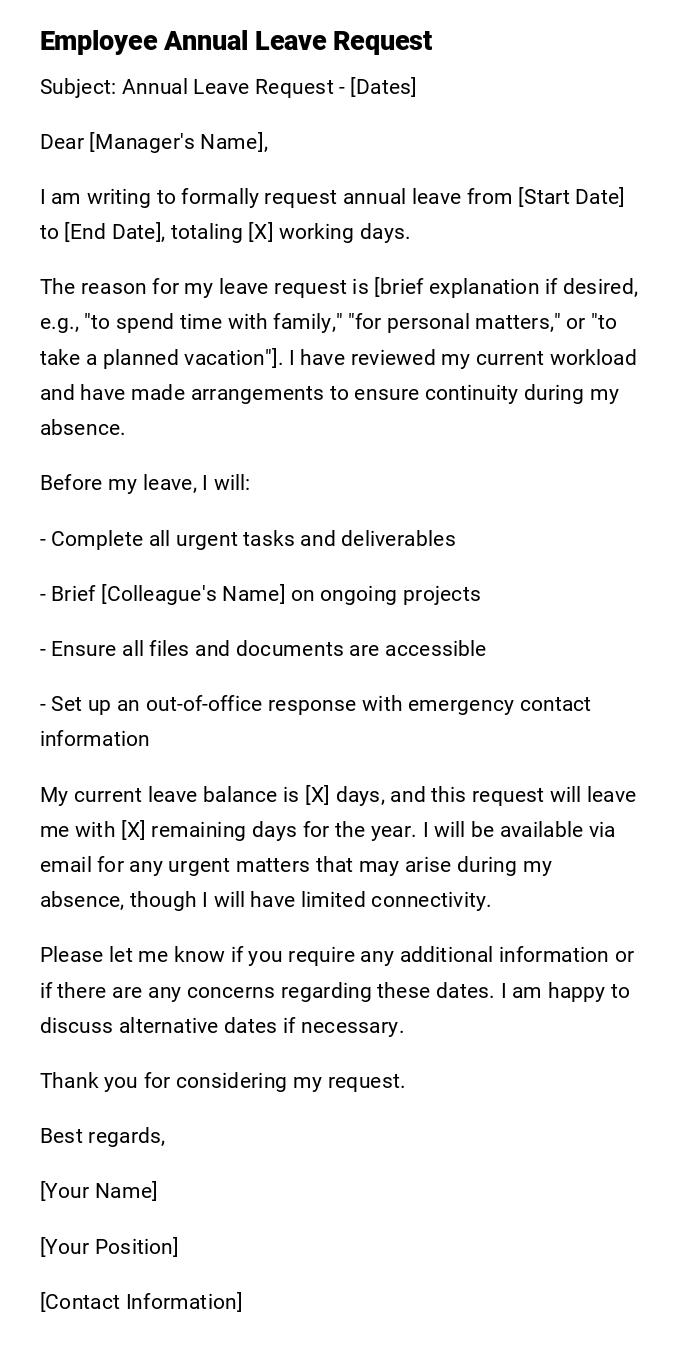
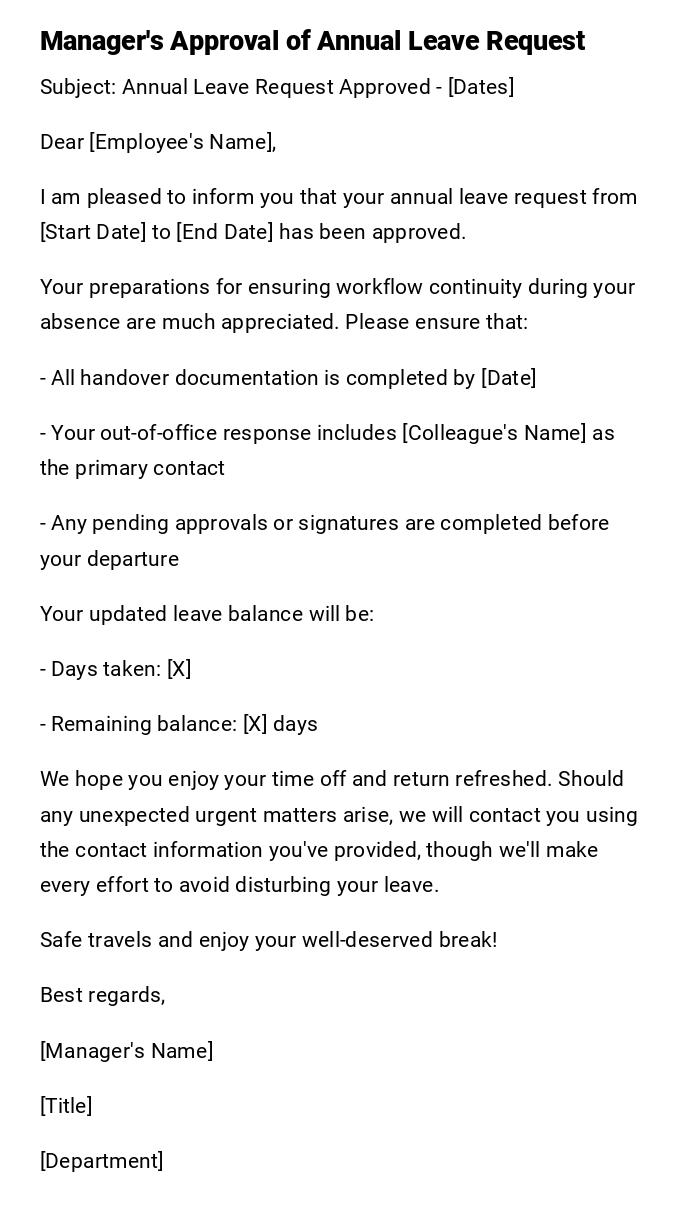
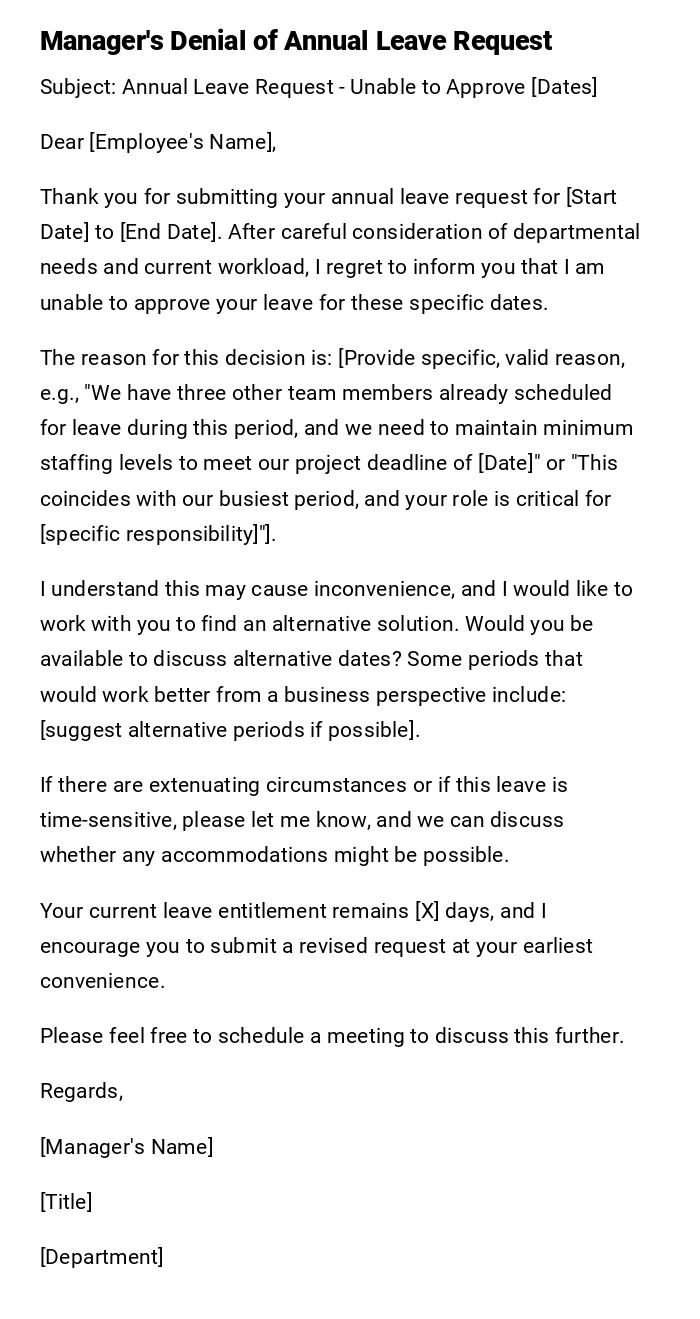
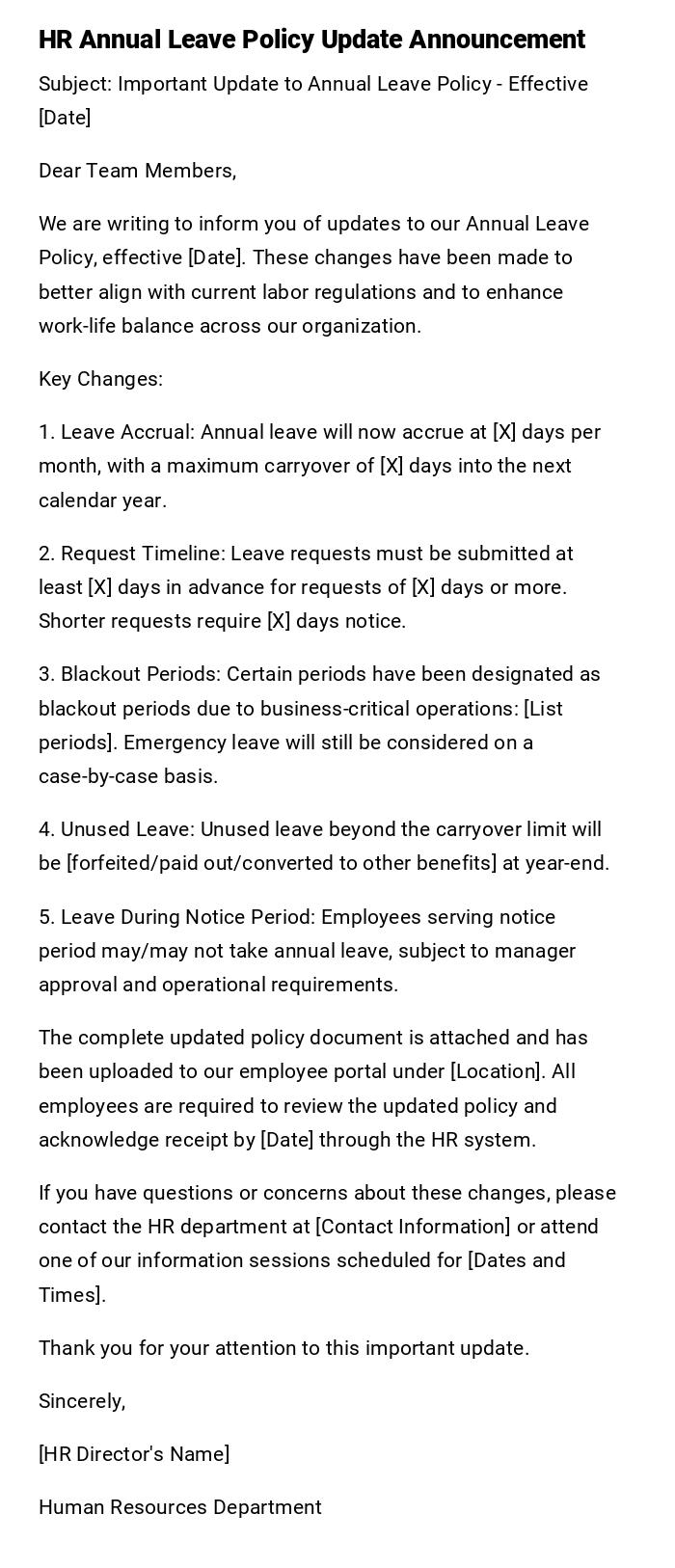
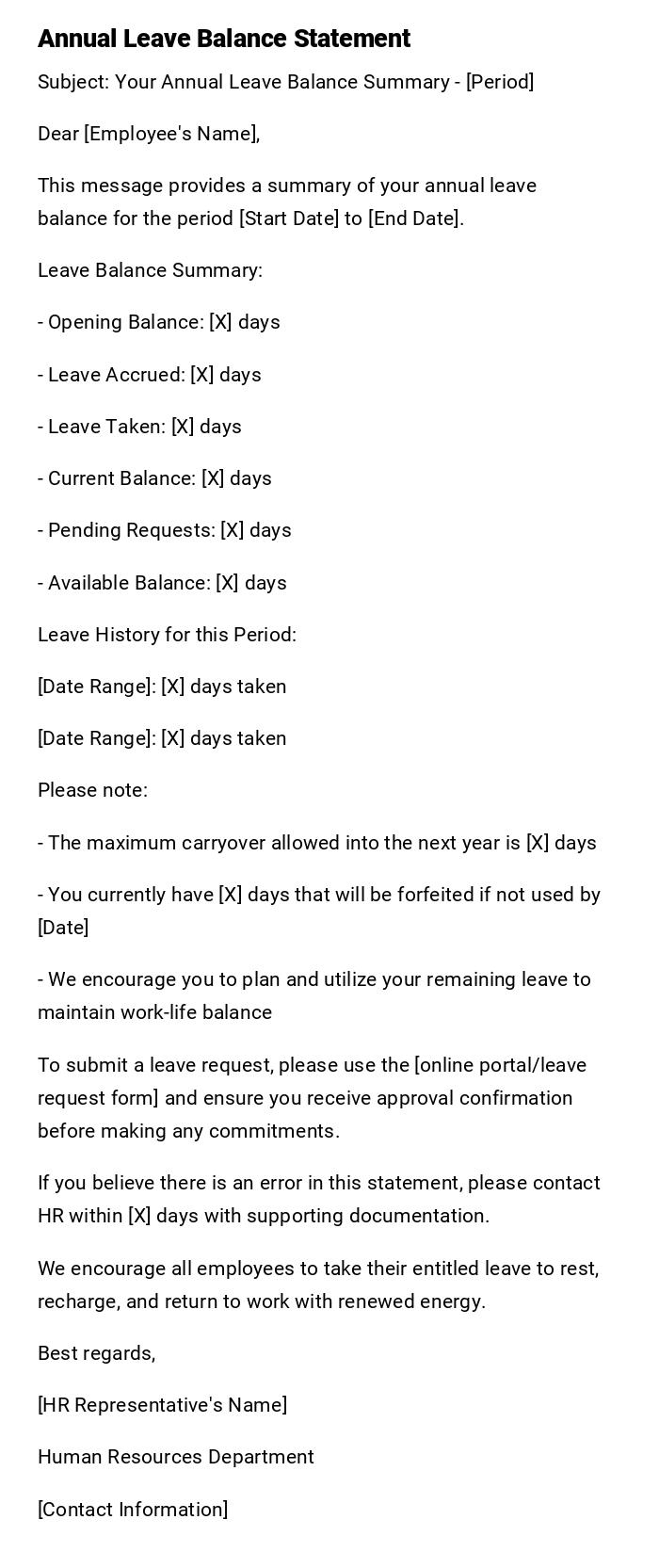
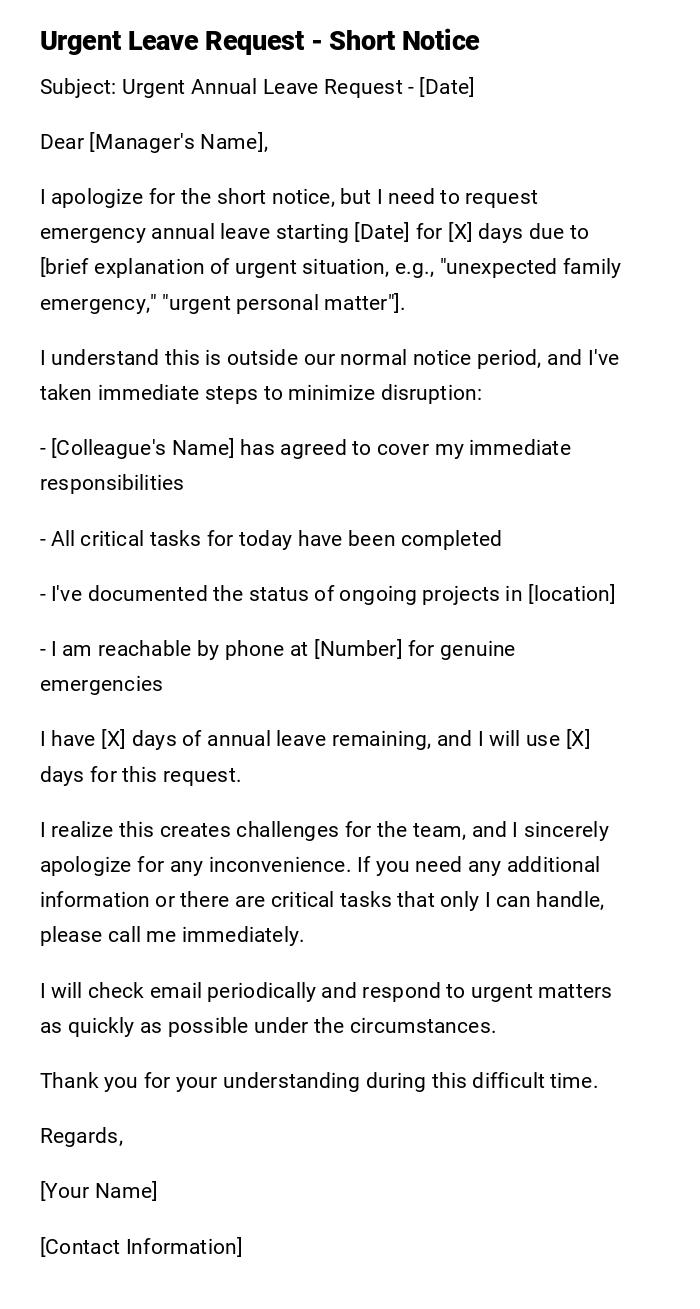
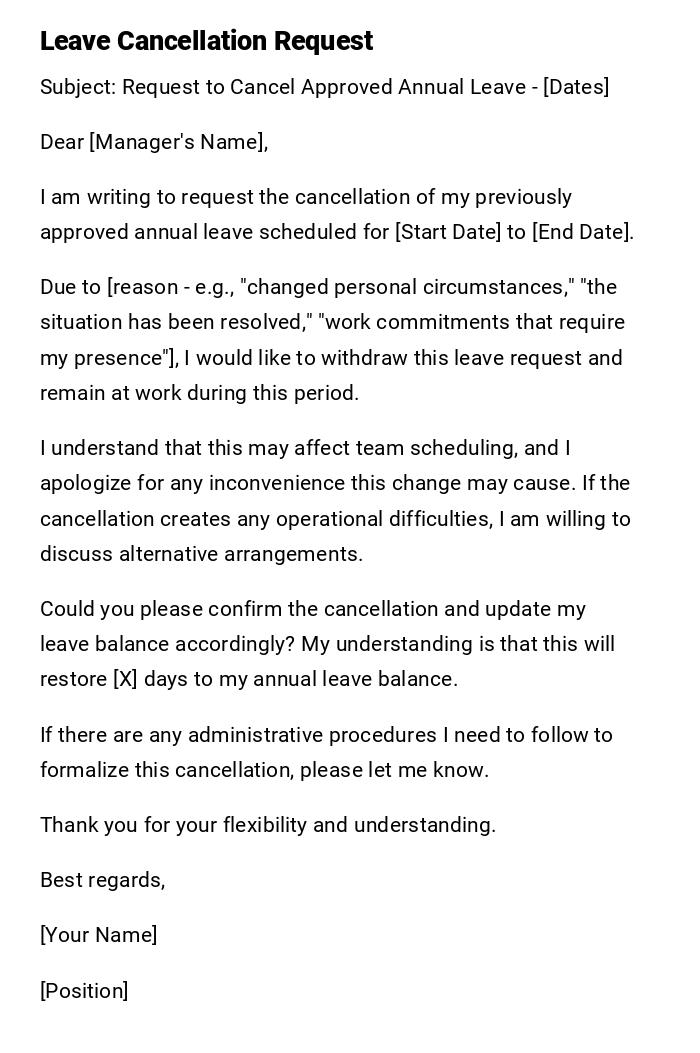
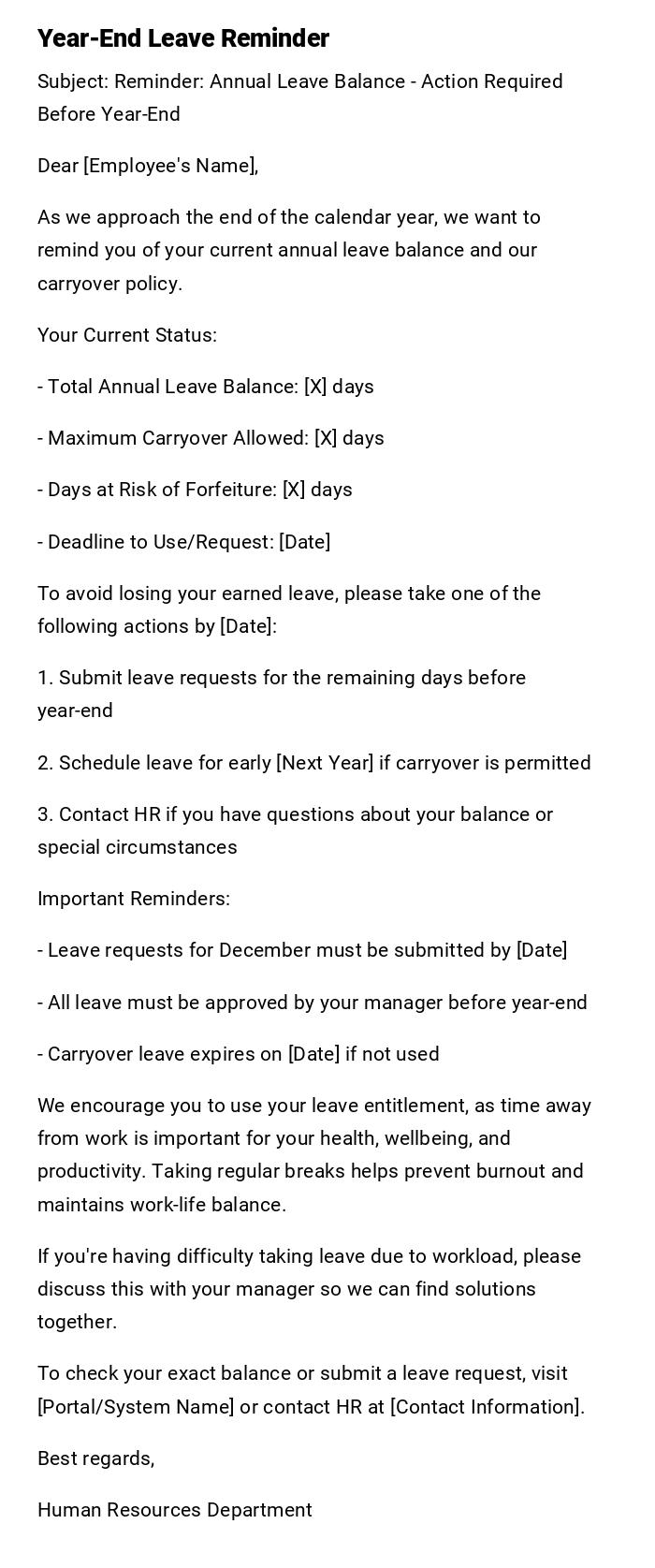
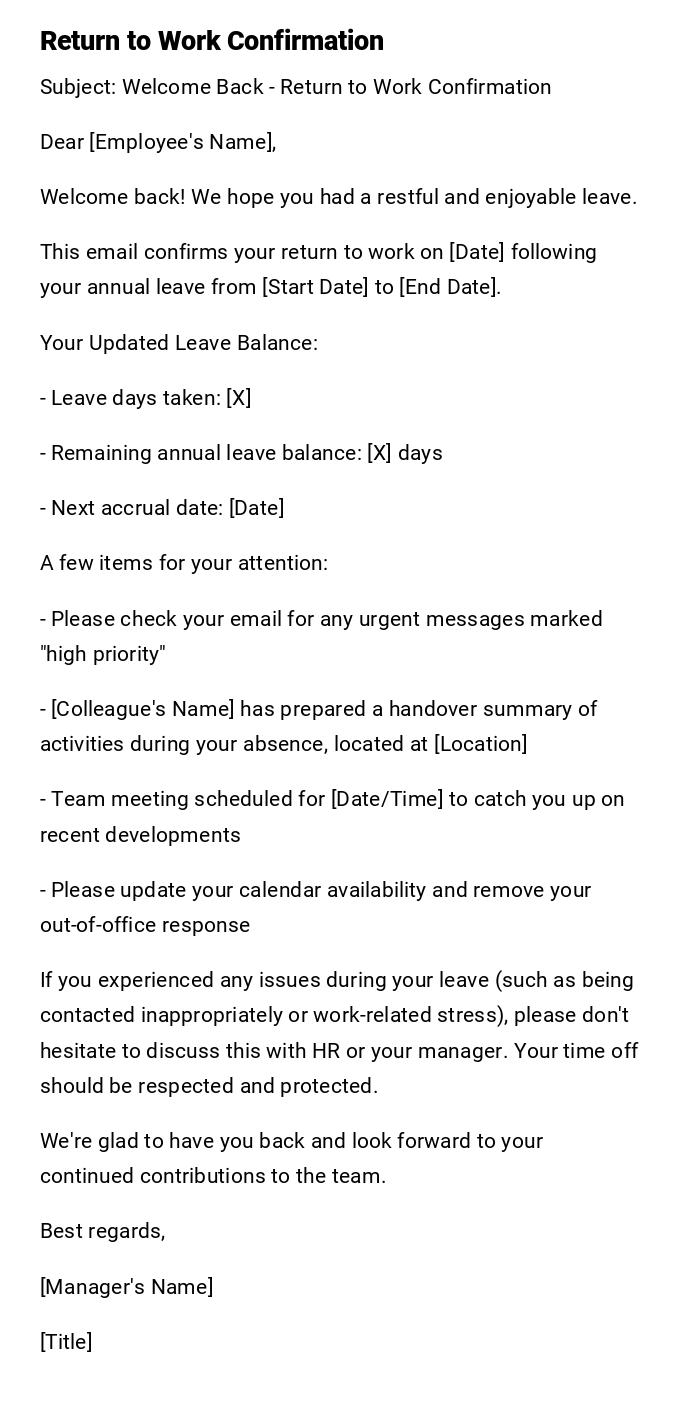

 Download Word Doc
Download Word Doc
 Download PDF
Download PDF